HONDA S2000 2003 1.G User Guide
Manufacturer: HONDA, Model Year: 2003, Model line: S2000, Model: HONDA S2000 2003 1.GPages: 280, PDF Size: 3.9 MB
Page 11 of 280
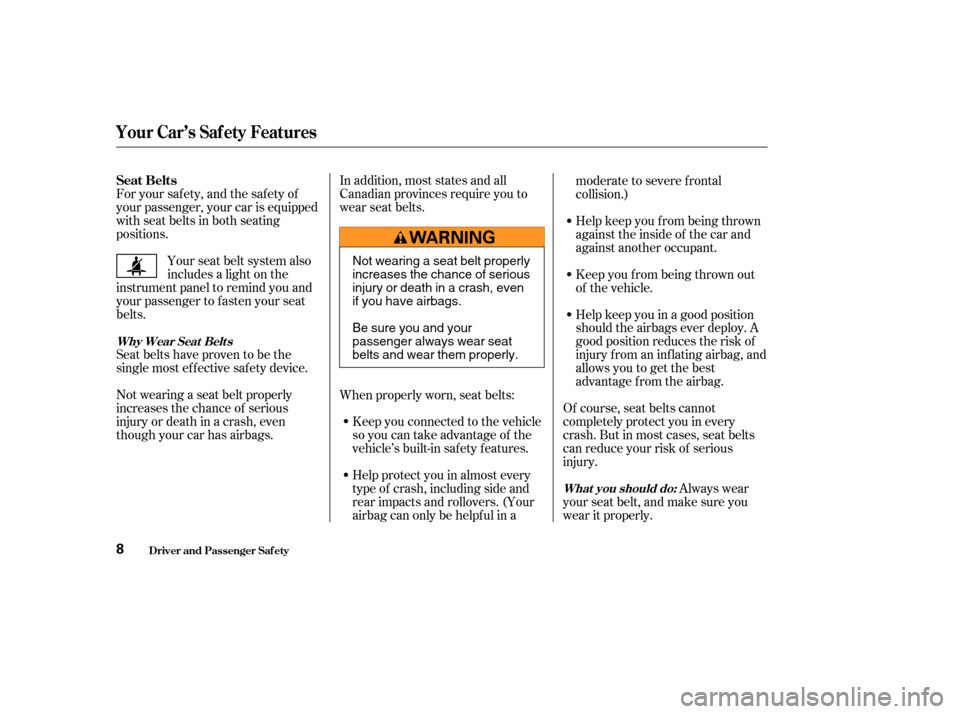
In addition, most states and all
Canadian provinces require you to
wear seat belts.
Foryoursafety,andthesafetyof
your passenger, your car is equipped
with seat belts in both seating
positions.
Seat belts have proven to be the
singlemosteffectivesafetydevice.
Not wearing a seat belt properly
increases the chance of serious
injury or death in a crash, even
though your car has airbags. Your seat belt system also
includes a light on the
instrument panel to remind you and
your passenger to f asten your seat
belts.
Always wear
your seat belt, and make sure you
wear it properly. Of course, seat belts cannot
completely protect you in every
crash.Butinmostcases,seatbelts
can reduce your risk of serious
injury. Help keep you in a good position
should the airbags ever deploy. A
good position reduces the risk of
injury f rom an inf lating airbag, and
allows you to get the best
advantage f rom the airbag. Keep you f rom being thrown out
of the vehicle.
Help protect you in almost every
type of crash, including side and
rear impacts and rollovers. (Your
airbag can only be helpful in a moderate to severe frontal
collision.)
Keep you connected to the vehicle
so you can take advantage of the
vehicle’s built-in saf ety f eatures.
When properly worn, seat belts: Help keep you f rom being thrown
against the inside of the car and
against another occupant.
Driver and Passenger Saf ety
Why Wear Seat Belt s
What you should do:
Your Car’s Saf ety Features
Seat Belts
8
Not wearing a seat belt properly
increases the chance of serious
injury or death in a crash, even
if you have airbags.
Be sure you and your
passenger always wear seat
belts and wear them properly.
Page 12 of 280
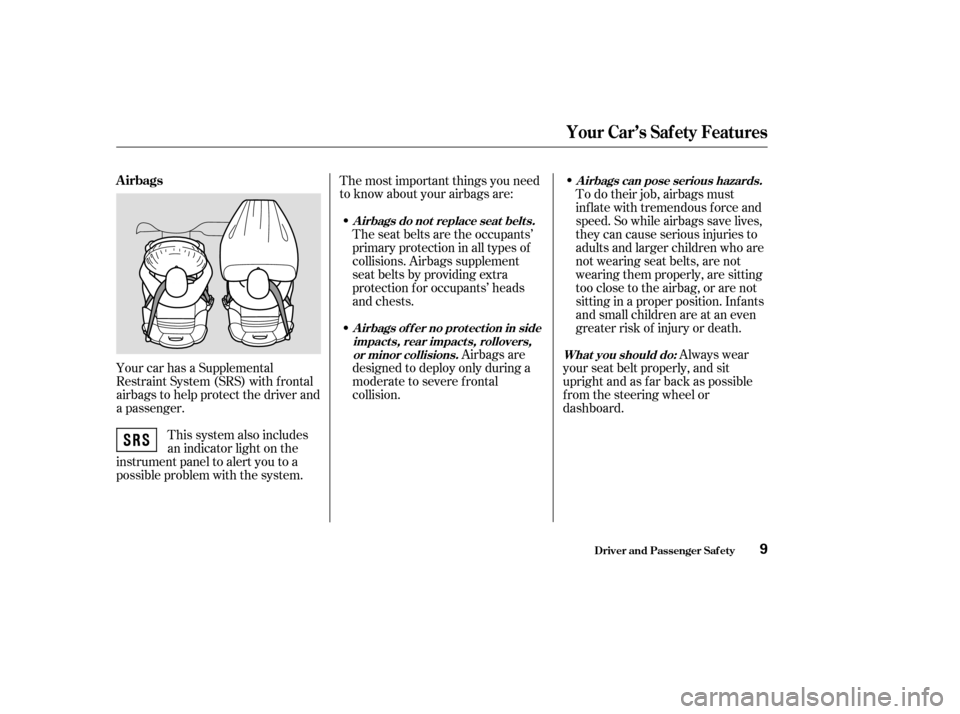
This system also includes
an indicator light on the
instrument panel to alert you to a
possible problem with the system. The most important things you need
to know about your airbags are:
Always wear
your seat belt properly, and sit
upright and as f ar back as possible
f rom the steering wheel or
dashboard. To do their job, airbags must
inf late with tremendous f orce and
speed. So while airbags save lives,
they can cause serious injuries to
adults and larger children who are
not wearing seat belts, are not
wearing them properly, are sitting
too close to the airbag, or are not
sitting in a proper position. Inf ants
and small children are at an even
greater risk of injury or death.
Your car has a Supplemental
Restraint System (SRS) with frontal
airbags to help protect the driver and
a passenger. Airbags are
designed to deploy only during a
moderate to severe frontal
collision. The seat belts are the occupants’
primary protection in all types of
collisions. Airbags supplement
seat belts by providing extra
protection f or occupants’ heads
and chests.
Driver and Passenger Saf ety
Airbags
What you should do:
Airbags can pose serious hazards.
Airbags of f er no protection in side impact s, rear impact s, rollovers,or minor collisions.
Airbags do not replace seat belts.
Your Car’s Saf ety Features
9
Page 13 of 280

Head restraints can help protect you
f rom whiplash and other injuries.Keeping your doors locked reduces
thechanceof beingthrownoutof
the car during a crash. It also helps
prevent occupants f rom accidentally
opening a door and f alling out, and
outsiders f rom unexpectedly opening
your doors.
Move the seats
as far back as possible, and keep
adjustable seat-backs in an upright
position whenever the car is moving.
Your car’s seats are designed to keep
you in a comf ortable, upright
position so you can take f ull
advantage of the protection offered
by seat belts and the energy
absorbing materials in the seats.
How you adjust your seats and seat-
backs can also affect your safety. For
example, sitting too close to the
steering wheel or dashboard
increases the risk of you or your
passenger being injured by striking
theinsideof thecar,orbyan
inf lating airbag.
Reclining a seat-back too f ar reduces
the seat belt’s ef f ectiveness and
increases the chance that the seat’s
occupant will slide under the seat
belt in a crash and be seriously
injured. Seats & Seat-Backs
Door L ocks
Head Restraints
Driver and Passenger Saf ety
Your Car’s Saf ety Features
What you should do:
10
Page 14 of 280

Seat-backs are upright (see page).
To make sure you and your
passenger get the maximum
protection f rom your car’s saf ety
f eatures, check the f ollowing each
time before you drive away:
A small child riding in a f orward-
f acing child seat is properly
restrained (see page ). Both doors are closed and locked
(see page ).
All cargo is properly stored or
secured (see page ).
Remember, however, that no saf ety
system can prevent all injuries or
deaths that can occur in severe
crashes, even when seat belts are
properly worn and the airbags deploy.
Occupants are sitting upright and
as far back as possible from the
steering wheel and dashboard
(see page ). You and any adult passenger, or a
larger child who has outgrown
child seats, are wearing your seat
belts and wearing them properly
(see page ). The rest of this section gives more
detailed inf ormation about how you
can maximize your saf ety.
15
26
13 12
12 128
Driver and Passenger Saf ety
Your Car’s Saf ety Features
Pre-Drive Saf ety Checklist
11
Page 15 of 280
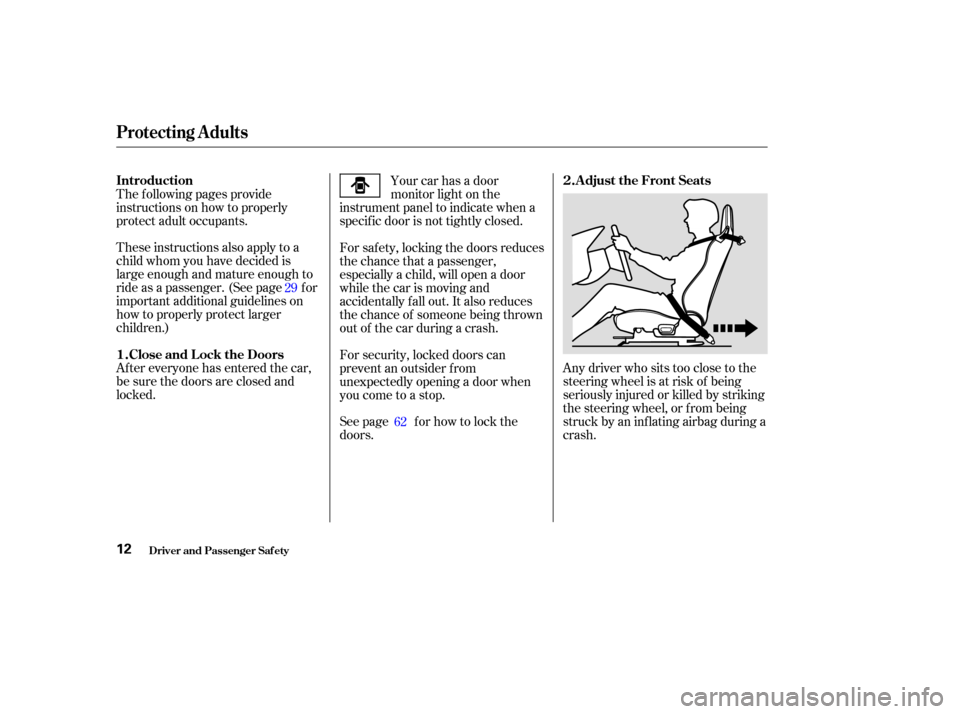
Any driver who sits too close to the
steering wheel is at risk of being
seriously injured or killed by striking
the steering wheel, or f rom being
struck by an inf lating airbag during a
crash.
Af ter everyone has entered the car,
be sure the doors are closed and
locked. The f ollowing pages provide
instructions on how to properly
protect adult occupants.
These instructions also apply to a
child whom you have decided is
large enough and mature enough to
ride as a passenger. (See page f or
important additional guidelines on
how to properly protect larger
children.) Your car has a door
monitor light on the
instrument panel to indicate when a
specif ic door is not tightly closed.
For saf ety, locking the doors reduces
the chance that a passenger,
especially a child, will open a door
while the car is moving and
accidentally f all out. It also reduces
the chance of someone being thrown
out of the car during a crash.
For security, locked doors can
prevent an outsider f rom
unexpectedly opening a door when
you come to a stop.
See page f or how to lock the
doors.
29
62
Driver and Passenger Saf ety
Protecting Adults
Introduction A djust the Front Seats
Close and L ock the Doors
1. 2.
12
Page 16 of 280
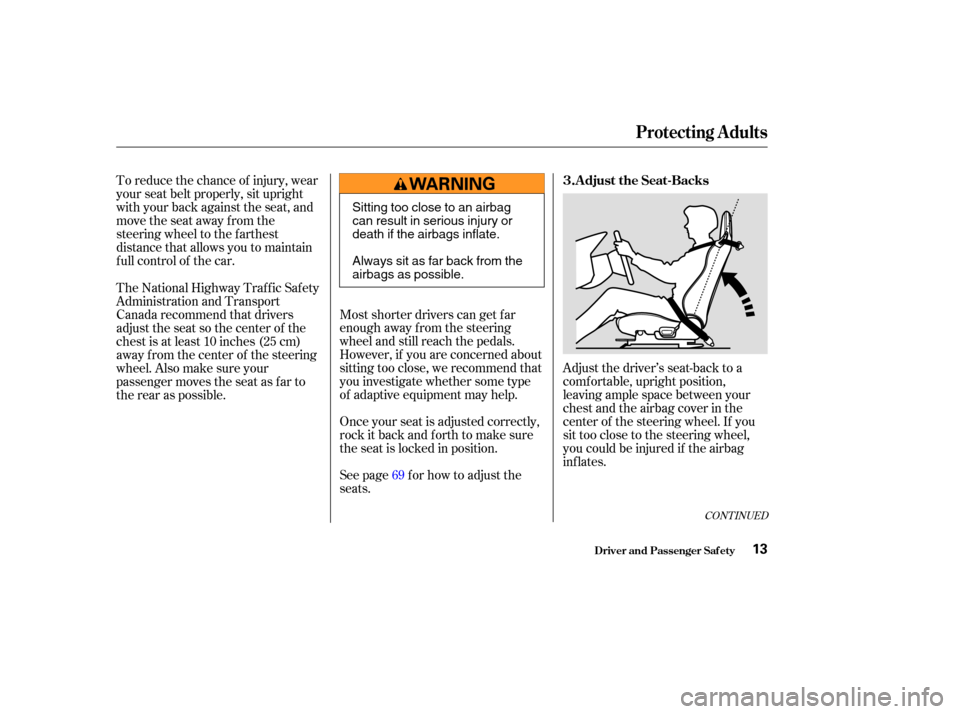
CONT INUED
To reduce the chance of injury, wear
your seat belt properly, sit upright
with your back against the seat, and
movetheseatawayfromthe
steering wheel to the f arthest
distance that allows you to maintain
f ull control of the car.Once your seat is adjusted correctly,
rock it back and f orth to make sure
the seat is locked in position.
See page f or how to adjust the
seats.Adjust the driver’s seat-back to a
comf ortable, upright position,
leaving ample space between your
chest and the airbag cover in the
center of the steering wheel. If you
sit too close to the steering wheel,
you could be injured if the airbag
inf lates.
Most shorter drivers can get f ar
enough away f rom the steering
wheel and still reach the pedals.
However, if you are concerned about
sitting too close, we recommend that
you investigate whether some type
of adaptive equipment may help.
The National Highway Traffic Safety
Administration and Transport
Canada recommend that drivers
adjust the seat so the center of the
chest is at least 10 inches (25 cm)
away f rom the center of the steering
wheel.Alsomakesureyour
passenger moves the seat as f ar to
the rear as possible.
69
Driver and Passenger Saf ety
Protecting Adults
Adjust the Seat-Backs
3.
13
Sitting too close to an airbag
can result in serious injury or
death if the airbags inflate.
Always sit as far back from the
airbags as possible.
Page 17 of 280
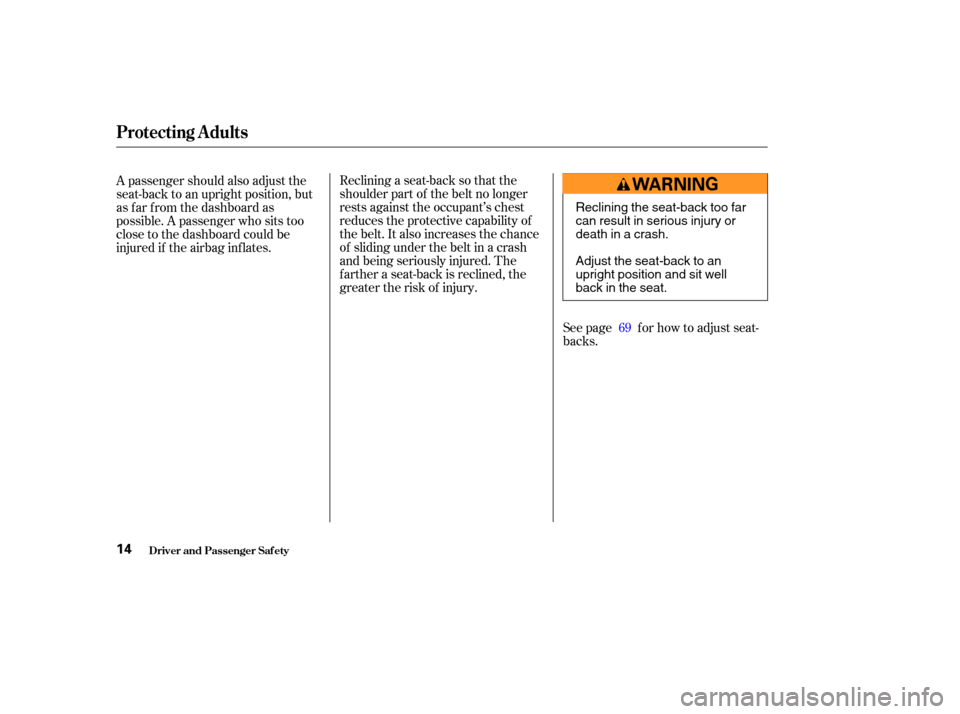
See page f or how to adjust seat-
backs.
Reclining a seat-back so that the
shoulder part of the belt no longer
rests against the occupant’s chest
reduces the protective capability of
the belt. It also increases the chance
of sliding under the belt in a crash
and being seriously injured. The
farther a seat-back is reclined, the
greater the risk of injury.
A passenger should also adjust the
seat-back to an upright position, but
as f ar f rom the dashboard as
possible. A passenger who sits too
close to the dashboard could be
injured if the airbag inflates.
69
Driver and Passenger Saf ety
Protecting Adults
14
Reclining the seat-back too far
can result in serious injury or
death in a crash.
Adjust the seat-back to an
upright position and sit well
back in the seat.
Page 18 of 280
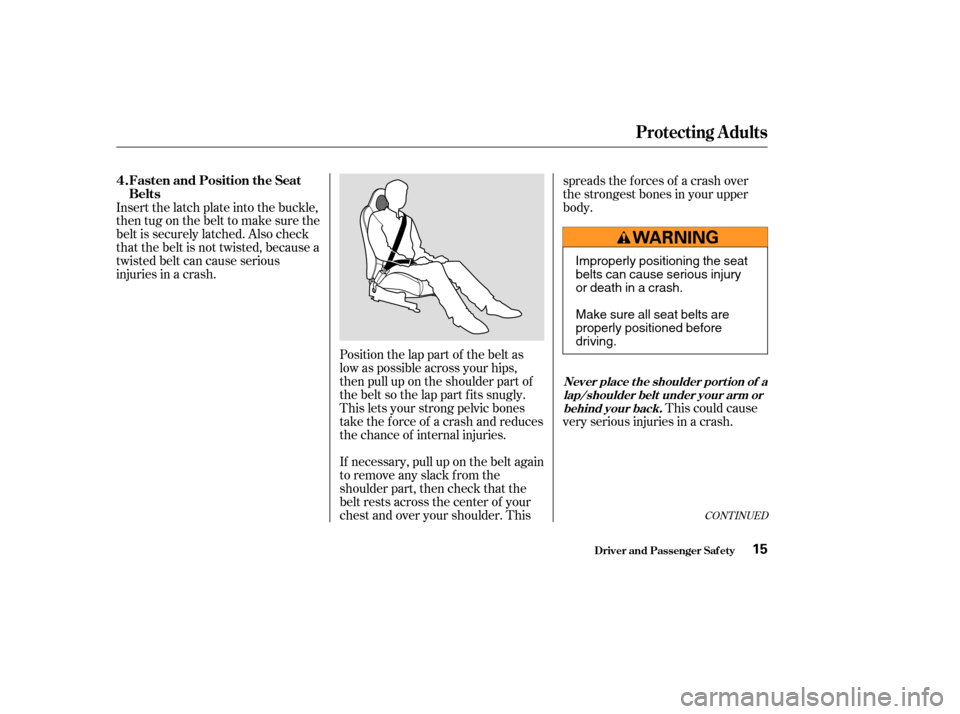
CONT INUED
Position the lap part of the belt as
low as possible across your hips,
then pull up on the shoulder part of
the belt so the lap part f its snugly.
This lets your strong pelvic bones
take the force of a crash and reduces
the chance of internal injuries.
Insert the latch plate into the buckle,
then tug on the belt to make sure the
belt is securely latched. Also check
that the belt is not twisted, because a
twisted belt can cause serious
injuries in a crash.
If necessary, pull up on the belt again
to remove any slack from the
shoulder part, then check that the
belt rests across the center of your
chest and over your shoulder. Thisspreads the f orces of a crash over
the strongest bones in your upper
body.
This could cause
very serious injuries in a crash.
Driver and Passenger Saf ety
Protecting Adults
Fasten and Position the Seat
Belts
4.
Never place t he shoulder port ion of a
lap/shoulder belt under your arm orbehind your back.
15
Improperly positioning the seat
belts can cause serious injury
or death in a crash.
Make sure all seat belts are
properly positioned before
driving.
Page 19 of 280
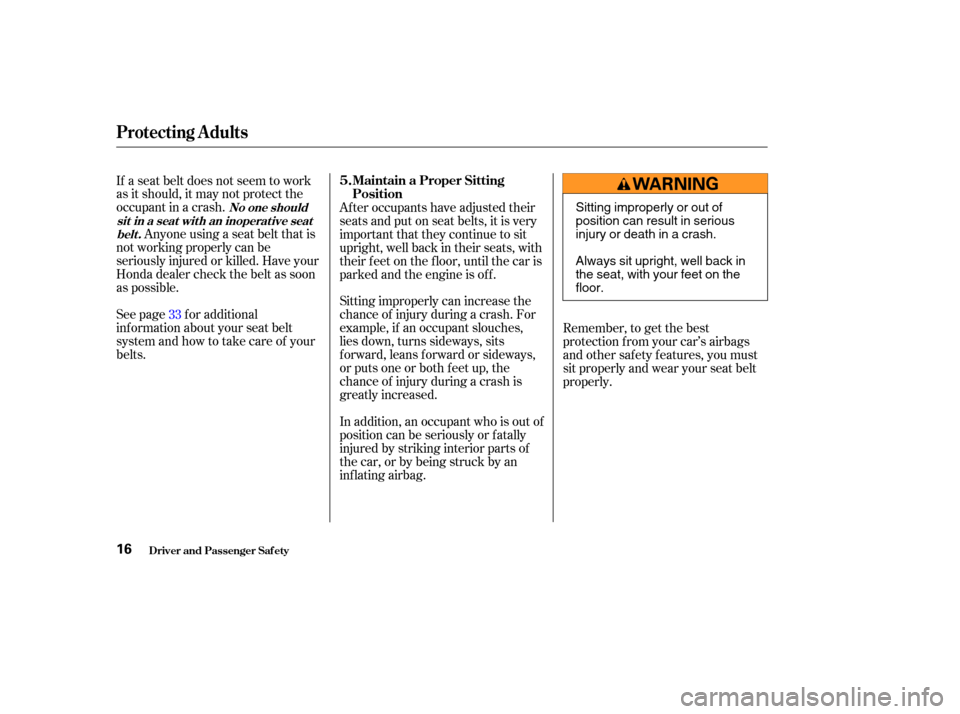
See page f or additional
inf ormation about your seat belt
system and how to take care of your
belts. If a seat belt does not seem to work
as it should, it may not protect the
occupant in a crash.Anyone using a seat belt that is
not working properly can be
seriously injured or killed. Have your
Honda dealer check the belt as soon
as possible. After occupants have adjusted their
seats and put on seat belts, it is very
important that they continue to sit
upright, well back in their seats, with
their feet on the floor, until the car is
parked and the engine is of f .
Sitting improperly can increase the
chance of injury during a crash. For
example, if an occupant slouches,
lies down, turns sideways, sits
forward, leans forward or sideways,
or puts one or both f eet up, the
chance of injury during a crash is
greatly increased.
In addition, an occupant who is out of
position can be seriously or f atally
injured by striking interior parts of
thecar,orbybeingstruckbyan
inf lating airbag.Remember, to get the best
protection f rom your car’s airbags
and other safety features, you must
sit properly and wear your seat belt
properly.
33
Driver and Passenger Saf ety
Protecting Adults
No one should
sit in a seat wit h an inoperat ive seat belt.
Maintain a Proper Sitting
Position
5.
16
Sitting improperly or out of
position can result in serious
injury or death in a crash.
Always sit upright, well back in
the seat, with your feet on the
floor.
Page 20 of 280
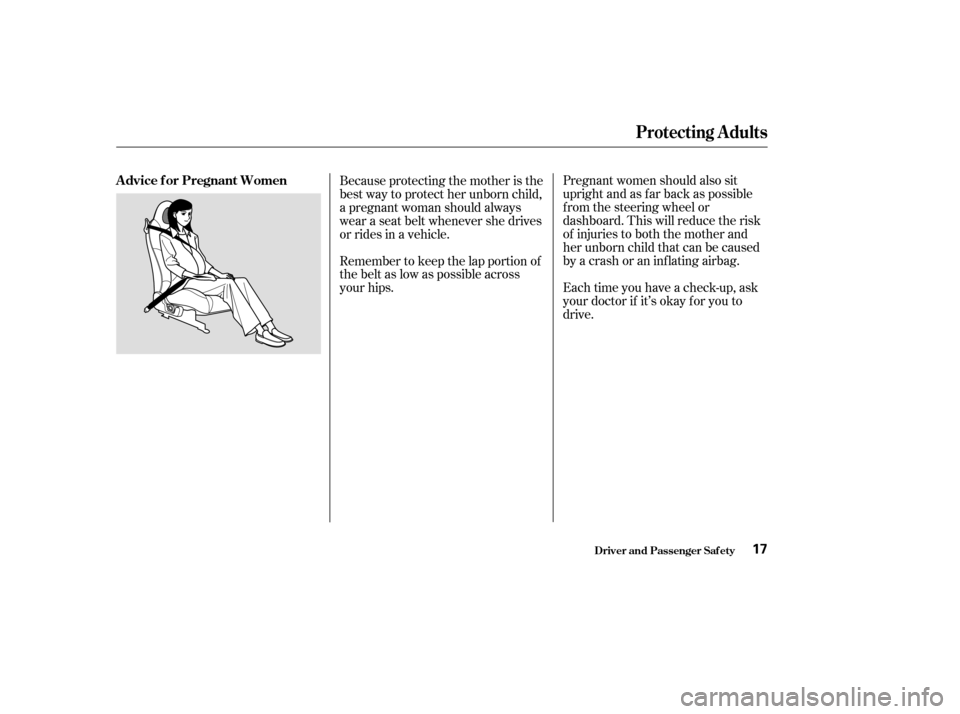
Pregnant women should also sit
upright and as f ar back as possible
f rom the steering wheel or
dashboard. This will reduce the risk
of injuries to both the mother and
her unborn child that can be caused
by a crash or an inf lating airbag.
Each time you have a check-up, ask
your doctor if it’s okay f or you to
drive.
Because protecting the mother is the
best way to protect her unborn child,
a pregnant woman should always
wear a seat belt whenever she drives
or rides in a vehicle.
Remember to keep the lap portion of
the belt as low as possible across
your hips.
Protecting Adults
Driver and Passenger Saf ety
Advice f or Pregnant Women
17